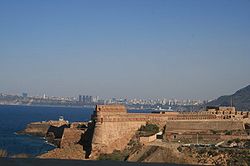
Alicante is a city and municipality in the Valencian Community, Spain. It is the capital of the province of Alicante and a historic Mediterranean port. The population of the city was 337,482 as of 2020, the second-largest in the Valencian Community.

Livorno is a port city on the Ligurian Sea on the western coast of the Tuscany region, Italy. It is the capital of the Province of Livorno, having a population of 158,493 residents in December 2017. It is traditionally known in English as Leghorn.

Castillo San Felipe del Morro, most commonly known as El Morro(The Promontory), is a large fortress and citadel in the historic district of Old San Juan, Puerto Rico. Commissioned by King Charles I of Spain in 1539, it was first built as a fortified tower in honor of King Philip II, who oversaw its expansion into a hornwork fort by 1595. Over the next 200 years, especially in the reign of King Charles III, El Morro continued to be developed to reach its current form in 1787. Rising 140 ft from the Atlantic shoreline with 18 to 25 ft thick walls, the six-leveled edifice stands on a steep, rocky headland promontory on San Juan Islet guarding the entry to San Juan Bay, the harbor of Old San Juan. El Morro, alongside La Fortaleza, San Cristóbal, El Cañuelo, and other forts part of the Walls of Old San Juan, protected strategically and militarily important Puerto Rico, or La Llave de las Indias , from invasion by competing world powers during the Age of Sail. It was designated a World Heritage Site by UNESCO in 1983.

Callosa d'en Sarrià (Valencian:[kaˈʎozaðensariˈa] is a Valencian town and municipality located in the comarca of Marina Baixa, in the province of Alicante, Spain, lying in the valley of the river Guadalest, 50 km from the city of Alicante. Callosa d'en Sarrià has an area of 24.8 km2 and according to the 2003 census, a total population of 8,060 inhabitants. The economy of Callosa is chiefly based on tourism and agriculture: it is the main producer of loquat in Spain. The most important monuments in the town are the Catholic archipresbyteral church of Sant Joan Baptista, built in the 18th century, and the Fortress of Bèrnia, built in the 17th century at the top of a nearby mountain to defend the city from pirates and Moriscos.

Tabarca, officially Nueva Tabarca and also known as Isla Plana (Spanish) and as Nova Tabarca and Illa Plana in Valencian, is an islet located in the Mediterranean Sea, close to the town of Santa Pola, in the province of Alicante, Valencian community, Spain. Tabarca is the largest island in the Valencian Community, and the smallest permanently inhabited islet in Spain. It is known for its marine reserve.
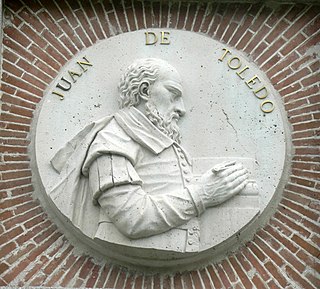
Juan Bautista de Toledo was a Spanish architect. He was educated in Italy, in the Italian High Renaissance. As many Italian renaissance architects, he had experience in both architecture and military and civil public works. Born, either in Toledo or in Madrid around 1515. He died on 19 May 1567 in Madrid, and was buried in Madrid in the choir of the primitive “Convento de Santo Tomás, Iglesia de la Santa Cruz”.
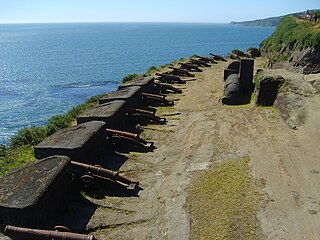
The Fort System of Valdivia is a series of Spanish colonial fortifications at Corral Bay, Valdivia and Cruces River established to protect the city of Valdivia, in southern Chile. During the period of Spanish rule (1645–1820), it was one of the biggest systems of fortification in the Americas. It was also a major supply source for Spanish ships that crossed the Strait of Magellan.

The Castillo de San Pedro de la Roca is a fortress on the coast of the Cuban city of Santiago de Cuba. About 6 miles (10 km) southwest of the city centre, it overlooks the bay. The fortress was declared a World Heritage Site by UNESCO in 1997, cited as the best preserved and most complete example of Spanish-American military architecture.

Paterna is a city and a municipality in the province of Valencia in the Valencian Community, Spain. It is located northeast of the comarca of L'Horta de Valencia, 5 kilometres northwest of the inland suburbs of Valencia, and on the left bank of the river Turia. Its population in 2014 was 67,156 inhabitants, being the eleventh city by population in the Valencian Community.
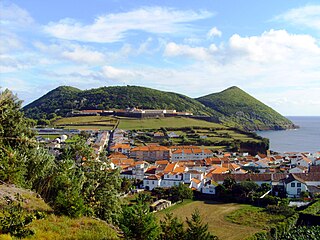
The Fortress of São João Baptista, also known as the Fort of São Filipe or Fort of Monte Brasil is a historic fortress and defensive emplacement, located in the civil parish of Sé, municipality of Angra do Heroísmo in the Portuguese island of Terceira, archipelago of the Azores.

The history of Alicante spans thousands of years. Alicante has been regarded as a strategic military location on the Mediterranean coast of Spain since ancient times. It is protected on the southwest by Cape Santa Pola and on the southeast by Cape Huerta. The fortified complex of Santa Bárbara Castle, the older parts of which were built in the 9th century, dominates the city from a height of 160 m atop Mount Benacantil, a rocky massif overlooking the sea.
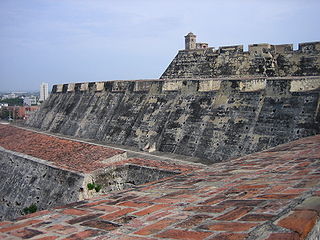
Battista Antonelli (1547–1616) was a military engineer from a prestigious Italian family of military engineers in the service of the Habsburg monarchs of Austria and Spain. He is credited with designing fortresses in Spanish colonial cities in the Caribbean, including Cartagena de Indias in Colombia, Havana in Cuba, and San Juan Bautista in Puerto Rico.
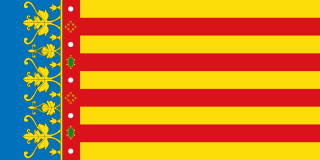
The Valencian Community is an autonomous community of Spain. It is the fourth most populous Spanish autonomous community after Andalusia, Catalonia and the Community of Madrid with more than five million inhabitants. Its homonymous capital Valencia is the third largest city and metropolitan area in Spain. It is located along the Mediterranean coast on the east side of the Iberian Peninsula. It borders Catalonia to the north, Aragon and Castilla–La Mancha to the west, and Murcia to the south, and the Balearic Islands are to its east. The Valencian Community is divided into three provinces: Castellón, Valencia and Alicante.
Giovanni Battista Calvi was an Italian military engineer at the service of the Spanish Monarchy during the 16th century.

The walls of Genoa constitute in their whole the several circles of walls that protected and defended the city of Genoa, former capital of the homonymous republic. To this day, large portions of these walls remain, and Genoa has more and longer walls than any other city in Italy.
Giovan Giacomo Paleari Fratino (1520–1586), known as El Fratin or Il Fratino, was a military engineer who served the Holy Roman Emperor and King of Spain Emperor Charles V, and then his son Philip II of Spain. He is known for having designed the first Martello tower as well as many other fortifications.
Tiburzio Spannocchi (1541–1609) was "king's engineer" to Philip II of Spain and subsequently to Philip III of Spain. He was named "Chief Engineer" in 1601.
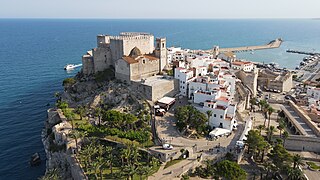
Peniscola Castle is a castle in Peniscola, Castellón, Valencian Community, Spain. The castle is restored and is open to the public.
In the late 16th century, the Spanish Empire attempted to settle the Strait of Magellan with the aim of controlling the only known passage between the Atlantic and Pacific oceans at the time. The project was a direct response to Francis Drake's unexpected entry into the Pacific through the strait in 1578 and the subsequent havoc his men wreaked upon the Pacific coast of Spanish America. The colonization effort took the form of a naval expedition led by veteran explorer Pedro Sarmiento de Gamboa, which set sail from Cádiz in December 1581. The expedition established two short-lived settlements in the strait, Nombre de Jesús and Ciudad del Rey Don Felipe. However, the settlers proved poorly prepared for the cool and windy environment of the strait, and starvation and disease was soon rampant. A resupply expedition organized by Sarmiento in Río de Janeiro in 1585 was unable to reach the strait due to unfavorable weather. Aid to the struggling colony was later hampered by Sarmiento falling prisoner to English corsairs in 1586 and the unresponsivity of King Philip II, likely due to the strain of Spain's resources caused by the wars with England and Dutch rebels. The last known survivor was rescued by a passing ship in 1590.

The coastal 'fortifications' of Spain in America are the works of military engineering that bear witness to the four hundred years of Spanish presence in America. They were built from northern California to Tierra del Fuego. Their purpose was the defense of port towns against the attack of the fleets of the English, French and Dutch armies, as well as corsairs and pirates.

